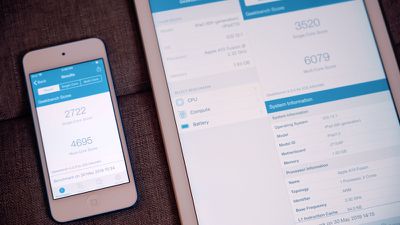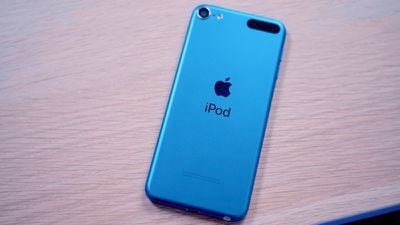Apple earlier this week introduced new iPod touch models, updating the 4-inch device for the first time since 2015. Not a lot has changed, but there's a new processor and updated storage tiers.
We thought we'd go hands-on with the new iPod touch to see if it still has a place in Apple's lineup in 2019 and who might want to purchase one.
The new 7th-generation iPod touch is now Apple's smallest device and the sole device that has a 4-inch display. The smallest iPhones (7 and 8) have 4.7-inch displays, so the new iPod touch is a good bit smaller and comparable to an iPhone 5s or SE.
Coming to a 4-inch iPod touch from a larger iPhone is quite an adjustment because most of us are no longer used to using a device with such a small display. It's tiny and it's made from a lightweight aluminum, which is nice if you need something you can just tuck in a pocket.

We have the iPod touch in blue, but it's also available in five additional colors: pink, (PRODUCT)RED, silver, gold, and space gray. As with the previous-generation iPod touch, there are thick bezels at the top and bottom of the device.
The bottom bezel houses a Home button, but unlike the iPhone, there's no Touch ID built in. There's also no Face ID, because the iPod touch has no biometric authentication system at all. You need to use a passcode for unlocking the device.
Camera tech hasn't been updated, so the new iPod touch is still using an 8-megapixel rear camera and a 1.2 megapixel front-facing camera, both of which are pretty far behind current camera technology in more modern Apple devices. For those who prefer wired headphones, there is a headphone jack.
The sole major update to the 7th-generation iPod touch is its new processor, which is an A10 Fusion chip that Apple first used in the 2016 iPhone 7 and iPhone 7 Plus. The A10 Fusion chip is a good bit faster than the A8 chip that was in the 6th-generation iPod touch, but it's worth noting that it's underclocked in this new model compared to other A10 devices.

The A10 chip in the iPod touch is running at 1.6GHz compared to 2.3GHz in the 6th-generation iPad and iPhone 7, both of which use the A10 chip. Apple is undoubtedly underclocking the processor to save battery life. Since this is a 4-inch device, it has a small battery.
The iPod touch earned a single-core Geekbench score of 2722 in our testing, and a multi-core score of 4695. That's a good bit slower than the 6th-generation iPad, which earned a single-core score of 3520 and a multi-core score of 6079.
It's faster than the 6th-generation iPod, though, which has a single-core Geekbench score of 1330 and a multi-core score of 2250. Apple also underclocked the A8 chip in the 6th-generation iPod touch, so having a chip that runs a bit slower in an iPod touch isn't new.
You can get the iPod touch with 32GB of storage for $199, while 128GB of storage will cost $299 and 256GB of storage (a new storage tier) will cost $399.

As for the question of who the iPod touch is for, it's not entirely clear. This is probably a good starter device for a younger child that needs access to games, FaceTime, iMessage, and other features, but there are also potential business applications, as this is an affordable device for something like mobile checkout. It could also be useful for schools looking for inexpensive Apple devices.
For the average person that has other Apple devices like an iPhone or iPad, you're probably not going to want to pick up an iPod touch unless you have a specific use case for it, such as listening to music with wired headphones while at the gym or something. Most people aren't going to have a use for an iPod touch over an iPhone, which is likely why it received only a modest processor update.
What do you think of the new iPod touch? Let us know in the comments.























